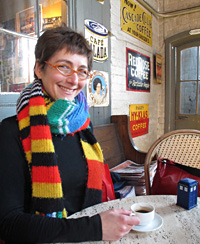Any knitter who reads the magazines knows the thrill of perusing the latest issue of a knitting magazine. And there's something special about the fall magazines. Fall is the knitter's favourite season: the promise of cooler weather and being able to reintroduce our favourite pieces into our wardrobes. (Although my commiserations for my friends in the UK who have been wearing sweaters a fair bit this summer.)
And so my copy of the Fall 2015 Knitscene arrived, and I did what I always did: eagerly flipped through it, for ideas and inspiration and to learn about new designers and new products and oogle the eye candy.
And oh yeah, and then bam: there's my name. TWICE.
As is always the case when you write a book - well, particularly when wordy-ol'-me writes a book, you write too much, and stuff needs to be cut. In this case, we had to cut two designs - the Prewitt slipped-stitch colourwork sock, and another one about which more news later.
I was a little sad to see these designs go, as I'd worked hard on them, and was proud of both of them. But the lovely Amy Palmer came to my rescue: she likes a good sock design, and was happy to take one of the orphans on and publish it in her magazine, KnitScene.
 |
| The no-longer orphaned Prewitt Sock. |
But wait there's more!
This issue of KnitScene introduces a new column: Pattern Play. And guess who's writing it?!
As a teacher, I know that one of the biggest challenges knitters have with patterns is in reading them. Knitting patterns are written in their own (sometimes arcane and mysterious) language, using strange notations and abbreviations. Learning to knit is one thing - a thing for which there are classes and books and all sorts of online resources. But reading patterns is an entirely different skill. And it's a skill for which there are relatively few resources. This column aims to rectify that. In the first one, I talk about how to read the yarn information in pattern to make sure you're buying the right type and quantity of yarn for your project. In future issues I'll explain what the fuss is about gauge and what it actually means; I'll explain common pattern writing conventions, how to read schematics and charts and all sorts of goodness. I hope that knitters find it helpful!
If there's a topic you'd like me to cover, let me know!
Print edition; digital edition.








No comments:
Post a Comment